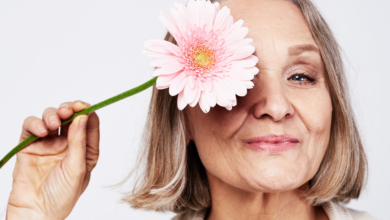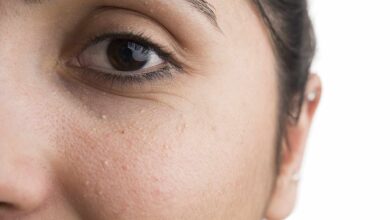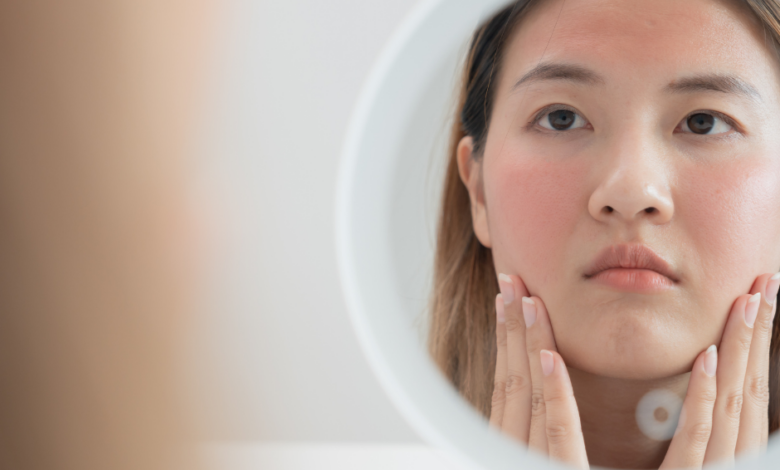
Ready to demystify rosacea? Let’s dive deep together! From uncovering its causes to spotlighting effective treatments and handy tips, this guide is all about helping you grasp the ins and outs of this skin challenge. With the right knowledge in your back pocket, you’re set to tackle rosacea head-on and find that much-needed relief. Let’s get started!
Causes of Rosacea
Rosacea is a chronic skin condition that affects millions of individuals worldwide. Although the exact cause of rosacea is still unknown, several factors have been identified as potential contributors to the development of the condition. These factors include genetics, environmental triggers, demodex mites, abnormalities in blood vessels, and immune system abnormalities.
Rosacea is a complex skin disorder characterized by persistent redness, visible blood vessels, and acne-like breakouts. While the precise etiology of rosacea remains elusive, researchers have made significant strides in identifying various factors that may contribute to its onset and exacerbation. Understanding these potential causes is crucial for effective management and treatment of this widespread condition.
Genetics
One of the leading causes of rosacea is believed to be genetics. Studies have shown that individuals with a family history of rosacea are more likely to develop the condition themselves. This suggests that certain genes may play a role in predisposing individuals to rosacea. However, more research is needed to fully understand the genetic factors that contribute to the development of this skin condition.
Environmental Triggers
Environmental triggers such as sun exposure, extreme temperatures, spicy foods, alcohol, and certain skincare products can exacerbate rosacea symptoms. These triggers can cause the blood vessels in the face to dilate, leading to increased redness and inflammation. It is important for individuals with rosacea to identify their personal triggers and take steps to avoid or minimize exposure to them.
Demodex Mites
Demodex mites are tiny organisms that live on the skin of most individuals without causing any problems. However, research has shown that individuals with rosacea have a higher population of these mites on their skin. It is believed that an exaggerated immune response to these mites may contribute to the development of rosacea. Further investigation is needed to fully understand the relationship between demodex mites and rosacea.
Abnormalities in Blood Vessels
Abnormalities in the blood vessels of the face are another potential cause of rosacea. Individuals with rosacea often have blood vessels that are easily dilated and prone to redness and inflammation. This can lead to the characteristic facial redness and visible blood vessels seen in rosacea. The exact mechanisms behind these abnormalities are still being researched.
Immune System Abnormalities
Immune system abnormalities have also been implicated in the development of rosacea. It is believed that an overactive immune response in individuals with rosacea leads to increased inflammation and blood vessel dilation. This immune dysfunction may be triggered by various factors, including genetics, environmental factors, and exposure to certain bacteria. Further research is necessary to fully understand these immune system abnormalities and their role in rosacea.
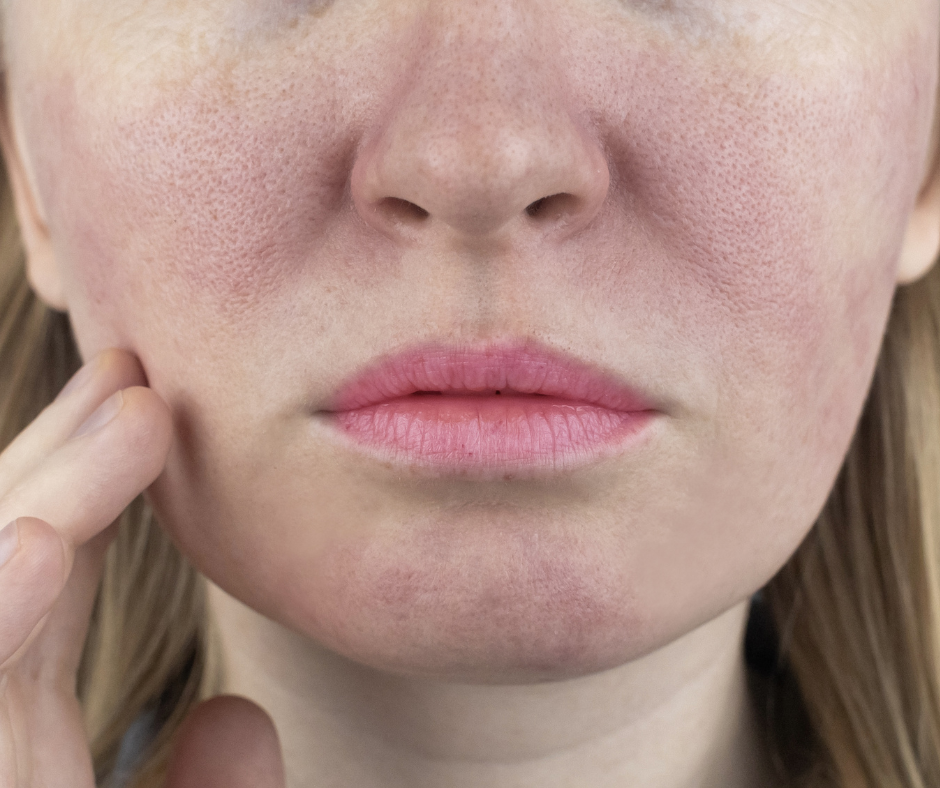
Identifying Rosacea Symptoms
Recognizing the symptoms of rosacea is crucial for early diagnosis and prompt treatment. The following are common symptoms associated with rosacea:
Facial Redness
Facial redness is one of the hallmark symptoms of rosacea. This redness often appears as a persistent blush or sunburn and can affect the cheeks, nose, forehead, and chin. The redness may come and go, or it may be constant, depending on the individual.
Visible Blood Vessels
In addition to facial redness, individuals with rosacea may have visible blood vessels on their face. These blood vessels, known as telangiectasias, appear as thin, red lines and can be seen on the cheeks, nose, and other areas of the face.
Pimple-like Bumps
Another common symptom of rosacea is the presence of pimple-like bumps on the skin. These bumps are usually red and can be accompanied by pus-filled pimples. Unlike acne, which typically affects the forehead and chin, rosacea-related bumps tend to appear on the central face.
Watery or Irritated Eyes
Rosacea can also affect the eyes, causing symptoms such as watery or irritated eyes. Individuals with ocular rosacea may experience dryness, a gritty sensation, redness, and sensitivity to light. If left untreated, ocular rosacea can lead to more severe eye problems, so early detection and treatment are essential.
Thickened Skin
In some cases, individuals with rosacea may develop thickened skin, particularly on the nose. This condition, known as rhinophyma, is more common in men and is characterized by a bulbous and enlarged appearance of the nose. Rhinophyma can be emotionally distressing for individuals and may require specialized treatment.
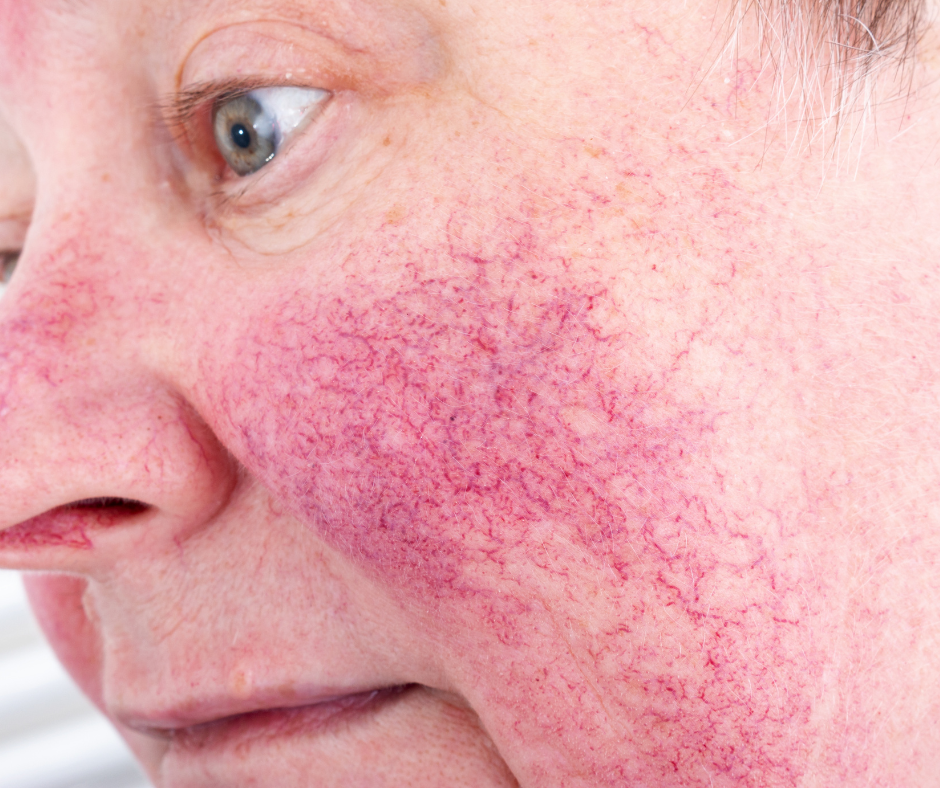
Diagnosing Rosacea
To diagnose rosacea, a healthcare professional will typically perform a combination of the following:
Physical Examination
During a physical examination, the healthcare professional will examine your skin and look for characteristic signs of rosacea, such as facial redness, visible blood vessels, and pimple-like bumps. They may also inquire about your symptoms and medical history to gather additional information.
Medical History
Providing a detailed medical history is crucial in diagnosing rosacea. It is important to inform your healthcare professional about any previous skin conditions, family history of rosacea, and any known triggers or exacerbating factors.
Additional Tests
In some cases, additional tests may be necessary to rule out other conditions that can mimic the symptoms of rosacea. These tests may include a skin biopsy, where a small sample of skin is taken for examination under a microscope, or a blood test to check for underlying medical conditions.
Types of Rosacea
Rosacea is a complex condition that manifests in different ways for different individuals. There are several subtypes of rosacea, each with its own distinct set of symptoms. The main types of rosacea include:
Erythematotelangiectatic Rosacea
Erythematotelangiectatic rosacea is characterized by persistent facial redness, visible blood vessels, and flushing. Individuals with this subtype may also experience stinging or burning sensations on the affected areas of their skin.
Papulopustular Rosacea
Papulopustular rosacea is often referred to as acne rosacea, as it is associated with pimple-like bumps and pus-filled pimples. Facial redness and visible blood vessels may also be present in this subtype.
Phymatous Rosacea
Phymatous rosacea is less common but can result in significant changes to the appearance of the skin. It is characterized by skin thickening and enlargement, particularly on the nose (rhinophyma), although other areas of the face can also be affected.
Ocular Rosacea
Ocular rosacea affects the eyes and can cause symptoms such as dryness, redness, itching, and sensitivity to light. It can lead to complications such as inflammation of the eyelids, conjunctivitis, and even vision problems if left untreated.
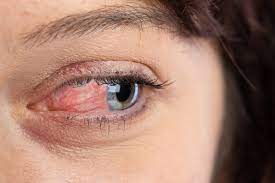
Treatment Options for Rosacea
While there is currently no cure for rosacea, there are several treatment options available to help manage and reduce the symptoms. The appropriate treatment for rosacea will depend on the type and severity of the condition and should be customized to each individual’s needs.
Topical Medications
Topical medications, such as metronidazole, azelaic acid, and sodium sulfacetamide, are commonly prescribed to treat mild to moderate rosacea. These medications work by reducing inflammation and controlling the redness and breakouts associated with rosacea.
Oral Medications
Oral antibiotics, such as doxycycline or tetracycline, may be prescribed for individuals with more severe cases of rosacea. These medications help to reduce inflammation and control symptoms, including facial redness and pimple-like bumps.
Laser and Light Therapies
Laser and light therapies are effective treatment options for managing rosacea symptoms. These therapies work by targeting and removing visible blood vessels, reducing redness, and improving the overall appearance of the skin.
Intense Pulsed Light (IPL)
Intense Pulsed Light (IPL) therapy uses broad-spectrum light to target and destroy visible blood vessels and reduce redness. This treatment is well-tolerated and can provide long-term improvement in the symptoms of rosacea.
Pulsed Dye Laser (PDL)
Pulsed Dye Laser (PDL) therapy specifically targets the blood vessels responsible for facial redness and visible blood vessels in rosacea. The heat from the laser damages the blood vessels, causing them to collapse and be reabsorbed by the body.
Electrosurgery
Electrosurgery is a procedure in which a high-frequency electric current is used to remove visible blood vessels and excess tissue. This treatment option is typically used for individuals with more advanced stages of rosacea, particularly those with rhinophyma.
Isotretinoin
Isotretinoin, a systemic medication typically used to treat severe acne, may also be prescribed in certain cases of rosacea. However, it is important to note that this medication has potential side effects and should only be used under the guidance and supervision of a healthcare professional.
Rosacea Triggers and Tips for Management
Managing rosacea involves identifying and avoiding triggers that can exacerbate symptoms. Here are some tips for managing rosacea and minimizing flare-ups:
Identifying Personal Triggers
Keeping a journal and noting any potential triggers that worsen your rosacea symptoms can be helpful. Common triggers include sun exposure, hot or spicy foods, alcohol, extreme temperatures, certain skincare products, and emotional stress. By identifying your personal triggers, you can take proactive steps to avoid or minimize exposure to them.
Avoiding Triggering Factors
Once you have identified your personal triggers, it is important to avoid or minimize your exposure to them. This might involve using sun protection, avoiding spicy foods or alcohol, adjusting your skincare routine, or finding healthy coping mechanisms for stress management.
Gentle Skincare Routine
Individuals with rosacea should adopt a gentle skincare routine to avoid irritation. It is recommended to use mild, non-abrasive cleansers and moisturizers specifically designed for sensitive skin. Harsh scrubs, exfoliants, and irritants should be avoided, as they can worsen redness and inflammation.
Choosing Rosacea-friendly Products
When selecting skincare and cosmetic products, it is important to choose those that are labeled as “rosacea-friendly” or “suitable for sensitive skin.” These products are typically free from common irritants and are less likely to trigger flare-ups.
Protecting Your Skin from Sun Exposure
Sun exposure is a common trigger for rosacea symptoms, so it is crucial to protect your skin from the sun’s harmful rays. This can be done by wearing broad-spectrum sunscreen, seeking shade during peak hours, and wearing protective clothing such as hats and sunglasses.
Managing Stress
Stress is known to exacerbate rosacea symptoms, so finding healthy ways to manage stress is important. This may involve practicing relaxation techniques, engaging in regular exercise, getting enough sleep, and seeking professional help or support when needed.
Protecting Your Skin in Cold Weather
Extreme temperatures, particularly cold weather, can trigger rosacea symptoms. To protect your skin in cold weather, it is recommended to wear a scarf or face mask to shield your face from the cold air and to moisturize your skin regularly to prevent dryness.
Maintaining a Healthy Diet
Although there is no specific diet that can cure rosacea, maintaining a healthy diet can contribute to overall skin health. Eating a balanced diet rich in fruits, vegetables, lean proteins, and whole grains can support optimal skin function and reduce inflammation.
Seeking Emotional Support
Living with rosacea can have emotional and psychological impacts, so seeking emotional support is crucial. Joining support groups, speaking with a therapist, or connecting with others who have rosacea can provide valuable support and help alleviate any emotional distress.

Natural Remedies for Rosacea
In addition to medical treatments, some individuals may find natural remedies helpful in managing their rosacea symptoms. While these remedies are not proven to cure or treat rosacea, they may provide relief and symptom management for some individuals. It is important to note that individual results may vary, and it is always best to consult with a healthcare professional before trying any natural remedies. Some natural remedies that may help with rosacea include:
Green Tea
Green tea has anti-inflammatory properties and can help reduce redness and inflammation associated with rosacea. Applying a cooled green tea compress or drinking green tea regularly may provide some relief.
Licorice Extract
Licorice extract is believed to have anti-inflammatory and soothing properties, making it potentially beneficial for rosacea symptoms. It is available in topical creams and gels, but care should be taken to choose products specifically formulated for sensitive skin.
Chamomile
Chamomile has soothing and anti-inflammatory effects, making it a popular natural remedy for rosacea. Applying cooled chamomile tea bags or using chamomile-infused skincare products may help calm redness and irritation.
Oatmeal Masks
Oatmeal masks can help soothe and moisturize irritated skin. Mixing ground oatmeal with water to create a paste and applying it to the affected area for 10-15 minutes can provide temporary relief from redness and inflammation.
Lavender Oil
Lavender oil has calming properties and may help reduce redness and irritation associated with rosacea. However, it is important to dilute lavender oil before applying it to the skin and to perform a patch test to check for any allergic reactions.
Aloe Vera
Aloe vera gel has been used for centuries to soothe and heal various skin conditions. Its anti-inflammatory properties may provide relief for individuals with rosacea. Applying a thin layer of pure aloe vera gel to the affected areas can help reduce redness and inflammation.
Honey
Raw honey has natural antibacterial and anti-inflammatory properties that may help soothe irritated skin. Applying a thin layer of raw honey to the affected areas for 10-15 minutes and then rinsing it off can provide temporary relief.
Cucumbers
Cucumbers have a cooling and calming effect on the skin and can help reduce redness and inflammation. Placing cool cucumber slices on the affected areas or using cucumber-infused skincare products may provide relief.
Probiotics
Probiotics are beneficial bacteria that can help support healthy gut and skin function. Some research suggests that taking probiotic supplements or consuming probiotic-rich foods may help reduce inflammation and improve rosacea symptoms.
Potential Complications of Rosacea
While rosacea itself does not pose any serious health risks, it can lead to certain complications if left untreated or poorly managed. Some potential complications of rosacea include:
Ocular Problems
Ocular rosacea can lead to various eye problems if not treated promptly. These problems may include dry eyes, conjunctivitis, blepharitis (inflammation of the eyelids), and even corneal damage. It is important for individuals with ocular rosacea to seek proper medical care to prevent any long-term complications.
Psychological Effects
Living with rosacea can have a significant impact on an individual’s self-esteem and psychological well-being. The visible symptoms of rosacea, such as facial redness and visible blood vessels, may cause embarrassment and self-consciousness, leading to social withdrawal and reduced quality of life.
Rhinophyma
In some cases, individuals with rosacea may develop rhinophyma, a condition characterized by thickening and enlargement of the nose. Although rhinophyma is rare, it can cause significant cosmetic concerns and may require surgical intervention to correct.
Coping with Rosacea Emotionally
Living with rosacea can be emotionally challenging, but there are strategies that can help individuals cope with the condition and maintain a positive outlook. Some tips for coping with rosacea emotionally include:
Educate Yourself
Learning about rosacea and understanding its causes, triggers, and treatment options can empower individuals to take control of their condition. Educating yourself through reliable sources can help dispel misconceptions and reduce anxiety.
Join Support Groups
Connecting with others who have rosacea can provide valuable emotional support and a sense of community. Joining support groups, either in person or online, can provide individuals with the opportunity to share experiences, seek advice, and gain emotional resilience.
Seek Professional Help
If rosacea is severely impacting your emotional well-being, seeking professional help from a therapist or counselor can be beneficial. They can provide guidance, support, and strategies for coping with any anxiety, depression, or body image issues that may arise from living with rosacea.
Practice Stress-reducing Activities
Managing stress is an important aspect of coping with rosacea. Engaging in stress-reducing activities such as meditation, deep breathing exercises, yoga, or hobbies can help individuals relax and improve their overall well-being.
Acceptance and Positive Outlook
Accepting that rosacea is a chronic condition and embracing a positive outlook can have a significant impact on emotional well-being. Focusing on self-care, practicing self-compassion, and surrounding yourself with a supportive network can help foster a positive mindset and enhance resilience in the face of rosacea.
Conclusion
Rosacea is a chronic skin condition characterized by facial redness, visible blood vessels, pimple-like bumps, and other symptoms. While the exact cause of rosacea remains unknown, genetics, environmental triggers, demodex mites, abnormalities in blood vessels, and immune system abnormalities are believed to contribute to its development.
It is essential to recognize and identify the symptoms of rosacea early on to receive prompt diagnosis and appropriate treatment. Diagnosing rosacea typically involves a physical examination, a medical history review, and potentially additional tests to rule out other conditions.
Treatment options for rosacea vary depending on the type and severity of the condition. Topical and oral medications, laser and light therapies, and other interventions can help manage symptoms and reduce the appearance of redness, visible blood vessels, and other associated skin issues.
While medical treatments are essential, it is also important for individuals with rosacea to identify and avoid triggers that can worsen symptoms. Adopting a gentle skincare routine, choosing suitable products, protecting the skin from sun exposure, managing stress, and maintaining a healthy lifestyle are crucial in managing rosacea and minimizing flare-ups.
In addition to medical treatments and lifestyle modifications, some individuals may find relief with natural remedies such as green tea, chamomile, and aloe vera. However, it is important to consult with a healthcare professional before trying any natural remedies to ensure they are safe and appropriate for individual use.
Coping with rosacea emotionally can be challenging, but education, support groups, professional help, stress-reducing activities, and a positive outlook can help individuals navigate the emotional aspects of living with this chronic condition.
Although rosacea can lead to certain complications if left untreated, proper management and early treatment can help prevent or minimize these complications. It is important for individuals with rosacea to work closely with healthcare professionals to develop a personalized treatment plan and address any potential concerns.
In conclusion, rosacea is a chronic skin condition that requires comprehensive management. By understanding the causes, symptoms, and treatment options, as well as adopting appropriate lifestyle modifications and coping strategies, individuals with rosacea can effectively manage their condition and improve their overall quality of life.


